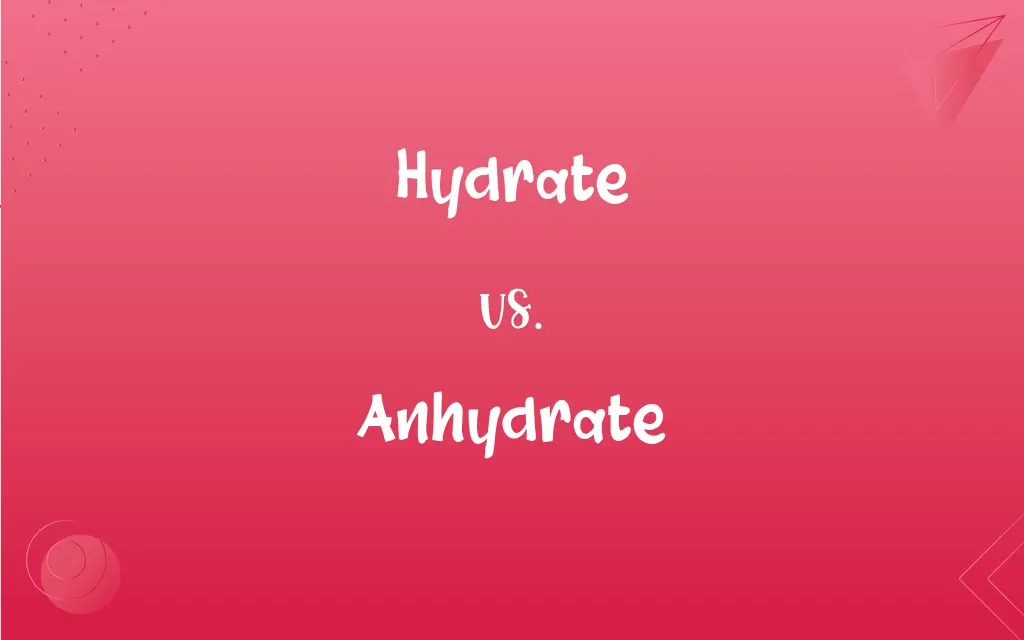Hydrate vs. Anhydrate: What's the Difference?
By Aimie Carlson & Harlon Moss || Published on March 5, 2024
Hydrate refers to compounds that include water molecules in their structure, while anhydrate is the term for substances from which water has been removed.

Key Differences
Hydrates are chemical compounds that contain water molecules incorporated into their structure, often as part of the crystallization process. An example would be copper sulfate pentahydrate. Anhydrates, in contrast, are substances that have had their water content removed, leading to a different chemical structure and properties than their hydrated counterparts. For instance, anhydrous copper sulfate is white, indicating the absence of water.
The water in hydrates is not merely trapped physically; it's chemically bonded to the host compound. This water can be integral to the compound's stability and appearance. Anhydrates lack these water molecules, which can lead to a significant alteration in their physical characteristics, such as color and form, and in their chemical behavior.
In the laboratory or industrial processes, creating an anhydrate from a hydrate involves applying heat to remove the water. This process is essential in various applications, including drying of chemicals and preservation of materials. Conversely, some anhydrates can reabsorb water from the air to revert to their hydrated form, a process known as rehydration.
Hydrates play a crucial role in several fields, including geology, where they can form significant mineral deposits. In chemistry, they are important for their unique properties, such as solubility and reactivity. Anhydrates are valued in areas where moisture absence is crucial, such as in electronics manufacturing and in the formulation of certain pharmaceuticals.
Hydration and dehydration processes are not merely physical changes but involve chemical reactions that alter the structure of the substances involved. This difference underscores the diverse applications and significance of hydrates and anhydrates in scientific and industrial contexts.
ADVERTISEMENT
Comparison Chart
Definition
Compound with water molecules in its structure.
Substance with water removed from its structure.
Water Content
Contains water molecules chemically bonded.
Lacks water molecules.
Physical Characteristics
Often changes color and form when hydrated.
Typically has different color and form.
Chemical Properties
Water contributes to stability and reactivity.
Absence of water affects reactivity and stability.
Usage
Crucial in geology, chemistry, and materials science.
Important in industries requiring dry conditions.
ADVERTISEMENT
Hydrate and Anhydrate Definitions
Hydrate
Forms through crystallization, incorporating water molecules.
Sodium carbonate decahydrate (washing soda) forms crystals with water.
Anhydrate
A substance from which water has been removed.
Anhydrous calcium chloride is used as a drying agent.
Hydrate
Can lose water through heating, becoming an anhydrate.
Heating copper sulfate pentahydrate removes water, turning it into an anhydrate.
Anhydrate
Utilized in situations where moisture must be controlled.
Anhydrous silica gel is used as a desiccant to control humidity.
Hydrate
Plays a role in the Earth's water cycle.
Mineral hydrates can store and release water in geological processes.
Anhydrate
Often more chemically reactive than its hydrated form.
Anhydrous aluminum chloride is a powerful Lewis acid.
Hydrate
Used in various industries for its properties.
Hydrates are used in construction materials for their setting properties.
Anhydrate
Features in manufacturing and pharmaceuticals.
Anhydrous solvents are essential in certain chemical syntheses.
Hydrate
A compound that contains water molecules within its structure.
Gypsum (CaSO4·2H2O) is a hydrate found in nature.
Anhydrate
Can absorb water to become a hydrate.
Anhydrous copper sulfate turns blue when it absorbs water.
Hydrate
A solid compound containing water molecules combined in a definite ratio as an integral part of the crystal. Often used in combination
Pentahydrate.
Anhydrate
(organic chemistry) An acid anhydride
Hydrate
To rehydrate.
Anhydrate
(chemistry) The anhydrous form of a normally hydrated compound
Anhydrate
To dehydrate, especially in food processing.
The Tarim mummies, found in present-day China, were anhydrated naturally by searing desert conditions.
FAQs
Can an anhydrate revert to a hydrate?
Yes, an anhydrate can absorb water from its surroundings and revert to its hydrated form, a process known as rehydration.
How do hydrates form?
Hydrates form through crystallization processes where water molecules are incorporated into the crystal lattice of the compound.
What changes occur when a hydrate becomes an anhydrate?
When a hydrate becomes an anhydrate, it loses water molecules, which can lead to changes in color, form, and chemical properties.
What are the uses of hydrates?
Hydrates are used in various fields, including construction, where they contribute to the setting properties of materials, and in geology, as part of the water cycle.
What does anhydrate mean?
An anhydrate is a substance from which water has been removed, lacking water molecules in its structure.
How does the removal of water from a hydrate affect its molecular structure?
The removal of water from a hydrate can lead to a reorganization of the molecular structure, affecting its chemical bonds and potentially altering its crystalline form.
Why are anhydrates preferred in certain chemical reactions?
Anhydrates are preferred in certain chemical reactions because the absence of water can increase reactivity, prevent unwanted side reactions, and improve yields.
What is a hydrate?
A hydrate is a compound that contains water molecules chemically bonded within its structure.
Why are anhydrates important in industry?
Anhydrates are crucial in industries that require the absence of moisture, such as in the manufacturing of electronics or the formulation of certain drugs.
What distinguishes a hydrate from other compounds?
A hydrate is distinguished by the presence of water molecules chemically bonded within its structure, which impacts its physical and chemical properties.
Are hydrates and anhydrates found naturally?
Yes, both hydrates and anhydrates can be found in nature. Mineral hydrates are common in geological formations, while anhydrates can form through natural dehydration processes.
Can all hydrates be converted into anhydrates?
While many hydrates can be converted into anhydrates by removing water, some may decompose or undergo chemical changes before becoming completely anhydrous.
What role do hydrates play in the environment?
Hydrates play a significant role in the environment by participating in the water cycle, acting as reservoirs of water in geological formations, and influencing climate patterns.
How are hydrates identified in laboratory settings?
Hydrates can be identified in laboratory settings through their physical properties, chemical reactions, and analytical techniques such as X-ray diffraction or thermal analysis.
Are there any health risks associated with hydrates or anhydrates?
Health risks associated with hydrates or anhydrates depend on the specific compound. Some may be harmless, while others could be toxic or corrosive, requiring appropriate handling and storage.
How does the presence of water in hydrates affect their properties?
The water in hydrates affects their physical and chemical properties, including solubility, reactivity, and appearance.
Can the process of hydration and dehydration be reversed?
Yes, the processes of hydration (adding water) and dehydration (removing water) can be reversed, allowing for the transition between hydrate and anhydrate forms.
Is it possible to determine the amount of water in a hydrate?
Yes, the amount of water in a hydrate can be determined through chemical analysis, such as by heating the compound to remove the water and measuring the loss in mass.
What safety considerations are there when working with anhydrates?
When working with anhydrates, safety considerations include managing their potential for water absorption, which can release heat, and their increased reactivity compared to their hydrated forms.
How are hydrates and anhydrates relevant in everyday life?
Hydrates and anhydrates are relevant in everyday life through their use in products like drying agents, construction materials, food preservation, and as part of the natural environment.
About Author
Written by
Aimie CarlsonAimie Carlson, holding a master's degree in English literature, is a fervent English language enthusiast. She lends her writing talents to Difference Wiki, a prominent website that specializes in comparisons, offering readers insightful analyses that both captivate and inform.
Co-written by
Harlon MossHarlon is a seasoned quality moderator and accomplished content writer for Difference Wiki. An alumnus of the prestigious University of California, he earned his degree in Computer Science. Leveraging his academic background, Harlon brings a meticulous and informed perspective to his work, ensuring content accuracy and excellence.
































































